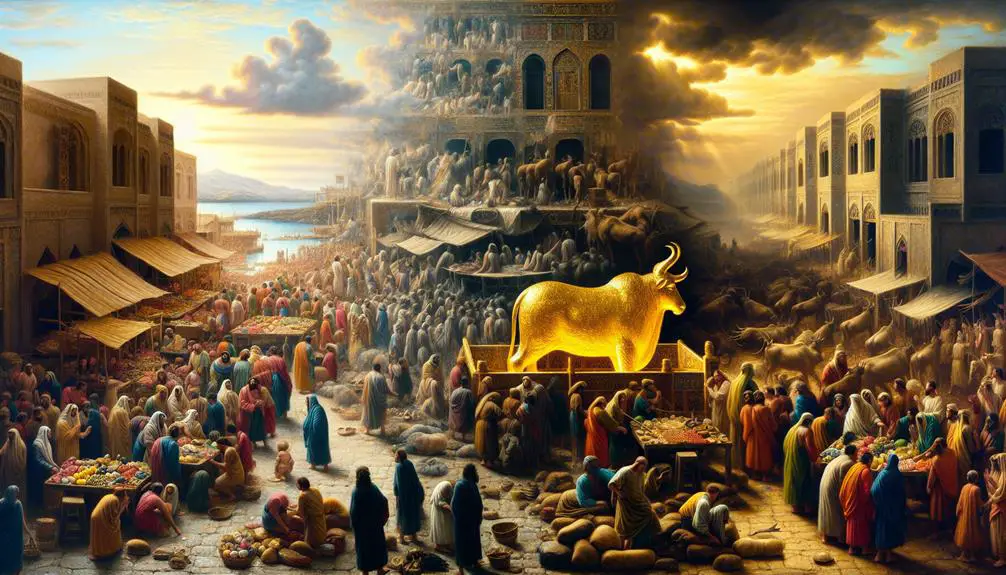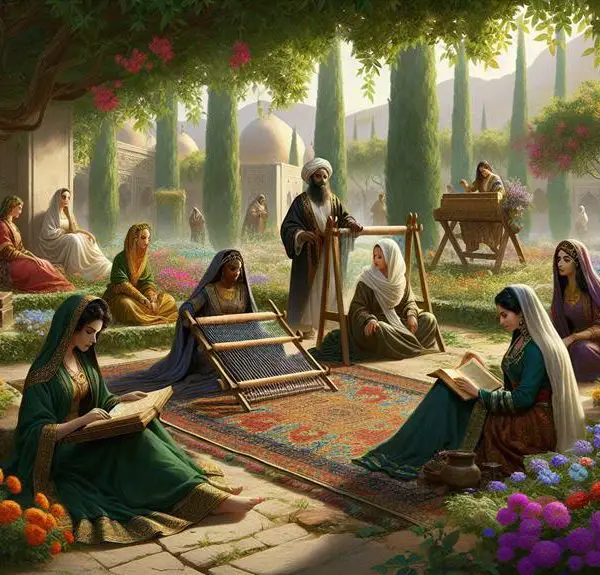Within the Bible, 'harlot' delves beyond mere prostitution, embodying themes of redemption and spiritual fidelity—discover the layered significance.

Harlot Meaning in the Bible
When you consider the story of Rahab in the book of Joshua, you encounter one of the Bible's most intriguing examples of a harlot's role within a sacred text. This term, often translated as 'prostitute' or 'whore' in English, carries a wealth of connotations and implications, both literal and metaphorical, throughout the scriptures.
The Bible's portrayal of harlotry encompasses not just physical prostitution but also spiritual infidelity against God. This complexity invites you to explore deeper, to uncover how these narratives of harlotry intertwine with themes of redemption, judgment, and grace.
What might initially seem a straightforward term opens up a rich tapestry of moral and theological discussion, challenging preconceived notions and inviting a nuanced understanding of biblical teachings on morality, sin, and forgiveness.
Key Takeaways
- The term "harlot" in the Bible often symbolizes spiritual apostasy and moral decay, beyond mere sexual immorality.
- Biblical narratives use harlotry to illustrate national infidelity and the consequences of straying from divine teachings.
- Jesus' interactions with individuals labeled as harlots demonstrate a compassionate approach, focusing on repentance and forgiveness.
- Stories of figures like Rahab and Mary Magdalene highlight the themes of redemption and the transformative power of faith and repentance.
Historical Context of 'Harlot

In exploring the historical context of 'harlot' within biblical texts, it's essential to recognize that this term has undergone significant evolution in both meaning and connotation over centuries. Initially, it encompassed a wide range of behaviors considered deviant by societal norms, not strictly limited to sexual immorality. As you delve deeper, you'll find that cultural shifts have played a pivotal role in shaping the term's interpretation and the attitudes toward those it describes.
Historically, the word 'harlot' reflected the prevailing societal norms and moral expectations of the time. Its application was influenced by cultural perceptions of gender roles, morality, and social order. It's crucial to understand that the term's negative connotations have been amplified or diminished in response to these changing societal values.
Moreover, the evolution of 'harlot' over time underscores the fluidity of language and morality. As societal norms evolved, so did the understanding and judgment associated with this term. Analyzing its historical context reveals not just changes in lexicon, but also shifts in societal attitudes toward morality, gender, and social status. This examination provides a nuanced view of how cultural and societal dynamics have influenced the interpretation of biblical texts.
Harlotry in the Old Testament

Reflecting on the historical context of 'harlot,' it's crucial to explore how the Old Testament portrays harlotry, revealing deep insights into ancient societal values and moral judgments. You'll find that harlotry, within these texts, isn't merely a profession but is deeply intertwined with cultural practices and legal consequences. This nuanced portrayal underscores the complexity of moral and social issues of the time.
The Old Testament frequently depicts harlotry in a negative light, associating it with betrayal, moral decline, and divine punishment. However, it's important to dissect these portrayals against the backdrop of cultural practices of the time. Harlotry is often linked with idolatry and foreign influence, reflecting societal concerns over purity, loyalty, and national identity.
Legal consequences for harlotry in the Old Testament are severe, ranging from public shaming to death. These punishments reflect the gravity of what harlotry represented in ancient times: a deviation from established social and divine orders. Yet, it's vital to consider these consequences within their historical and cultural context, understanding that they represent a specific worldview and set of values that informed ancient legal and moral frameworks.
Symbolism and Metaphor

One often encounters harlotry employed as a powerful metaphor and symbol within the biblical narrative, revealing layers of meaning that go beyond its literal interpretation. This symbolism is deeply intertwined with allegorical interpretations and cultural perceptions, offering a rich tapestry for analysis.
Here are four key aspects to consider:
- National Infidelity: Harlotry is frequently used to symbolize the infidelity of nations, particularly Israel, towards God. This metaphor underscores the betrayal of a covenant relationship, likening it to the unfaithfulness of a harlot.
- Spiritual Apostasy: Beyond physical unfaithfulness, the metaphor extends to spiritual apostasy, representing a departure from divine teachings and the embrace of idolatrous practices.
- Moral Degradation: The use of harlotry as a metaphor also comments on moral and ethical decay within society. It reflects cultural perceptions of sin and the erosion of societal values.
- Divine Judgment: Allegorical interpretations often associate harlotry with impending divine judgment. This symbolism serves as a warning to the faithful, urging repentance and a return to righteous living.
Through these layers of metaphor, the biblical usage of harlotry challenges readers to reflect on their own spiritual fidelity and moral integrity.
New Testament Perspectives

As you explore the New Testament perspectives on harlotry, you'll encounter its moral implications, significantly shaped by the interactions between Jesus and individuals labeled as harlots.
These narratives underscore the transformative power of repentance and forgiveness, offering a new path for those marginalized by society. This shift not only highlights the compassionate approach of Jesus but also redefines societal perceptions of morality and redemption.
Harlotry: Moral Implications
In the New Testament, harlotry is often regarded as not only a sin of moral failure but also as a metaphor for spiritual unfaithfulness to God. This depiction underlines both ethical considerations and societal judgments towards such actions.
- Ethical considerations stress personal integrity and moral responsibility.
- Societal judgments reflect the collective disapproval and consequences of harlotry.
- The metaphorical use emphasizes the gravity of turning away from divine commandments.
- Spiritual unfaithfulness is paralleled with physical acts of harlotry, enhancing the moral implications.
This analysis underscores the complexity of harlotry's portrayal, balancing between literal interpretations and symbolic meanings within a New Testament context.
Jesus and the Harlot
Building on the moral and spiritual framework previously discussed, the New Testament introduces specific encounters between Jesus and women accused of harlotry, offering a nuanced exploration of compassion, judgment, and redemption. These narratives highlight Jesus' revolutionary approach to individuals society deemed immoral, challenging cultural misunderstandings and norms of the time. His interactions often reveal a deeper message about human dignity and the possibility for transformation, rather than a mere denouncement of sin.
Feminist critiques have further analyzed these accounts, arguing that they expose, and even subvert, patriarchal assumptions about women's sexuality and moral agency. Instead of reinforcing stereotypes, Jesus' engagements with these women question societal labels and invite a reevaluation of worth and identity, setting a profound precedent for inclusion and empathy.
Repentance: A New Path
Within the New Testament narratives, the concept of repentance emerges as a transformative pathway, offering individuals mired in sin a chance to realign with divine expectations and societal norms. This process is pivotal in understanding forgiveness dynamics and ethical transformations within biblical contexts.
- Acknowledgment of Sin: You're encouraged to confront your wrongdoings openly.
- Sincere Regret: It's not just about recognizing your sins but feeling true remorse for them.
- Commitment to Change: You're urged to make a genuine effort to alter your behavior and align more closely with ethical and spiritual principles.
- Seeking Forgiveness: This involves both divine forgiveness and reconciliation with those you've wronged, emphasizing the relational aspect of repentance.
These steps reflect a deeper understanding of repentance, beyond mere ritual, as a profound, personal journey toward renewal and redemption.
Prostitution Vs. Spiritual Infidelity

You must understand that in the Bible, prostitution isn't merely a physical act but also carries deep symbolic significance, representing spiritual infidelity against God.
This comparison between physical and spiritual unfaithfulness highlights the profound moral and ethical concerns within the scriptural texts.
Analyzing these concepts allows you to grasp the complex layers of meaning behind the term 'harlot' as used in biblical narratives.
Prostitution's Biblical Context
In the Bible, prostitution not only signifies a physical act but also serves as a metaphor for spiritual infidelity against God. This complex subject is explored through various lenses, including:
- Legal ramifications: The scriptures outline specific consequences and legal boundaries surrounding prostitution, reflecting its perceived severity.
- Societal attitudes: Attitudes towards individuals involved in prostitution varied, often reflecting broader societal norms and values.
- Moral implications: The act is frequently depicted as contrary to God's commandments, highlighting moral and ethical considerations.
- Cultural context: Understanding prostitution within the biblical era requires recognizing its cultural and historical backdrop, which influenced perceptions and responses.
Through this analytical lens, you can appreciate the multifaceted role prostitution plays in biblical narratives, extending beyond mere physical transactions to encompass broader themes of faithfulness and moral integrity.
Symbolic Spiritual Unfaithfulness
The term 'harlotry' in biblical texts often transcends its literal interpretation to symbolize the profound betrayal of spiritual infidelity towards God. This metaphorical use conveys a deep violation of divine relationships, akin to the unfaithfulness of a harlot.
The scriptures frequently employ this analogy to critique the Israelites' deviation from faithful worship, equating their worship of idols and foreign gods to the act of a spouse straying from their marital vows. This conceptual leap from physical to spiritual unfaithfulness serves to underscore the gravity of abandoning one's commitment to God.
It's a powerful reminder that in the biblical perspective, maintaining a pure and devoted relationship with the divine is paramount to faithful worship.
Comparing Physical and Spiritual
Understanding the distinction between physical harlotry and spiritual infidelity is crucial for a deeper comprehension of biblical teachings on faithfulness.
- Physical Harlotry: Often rooted in violations of sexual morality, it's viewed through the lens of individual actions against cultural norms and divine commands.
- Spiritual Infidelity: Represents a broader betrayal, encompassing a heart turned away from divine allegiance in favor of idolatry or false ideologies.
- Cultural norms influence the interpretation and condemnation of physical harlotry, whereas spiritual infidelity transcends cultural boundaries, pointing to a universal expectation of faithfulness to spiritual commitments.
- Consequences and Redemption: Both forms of unfaithfulness entail consequences, yet biblical narratives also offer paths to redemption, emphasizing the possibility of returning to a state of spiritual purity and integrity.
Redemption Narratives

Within biblical narratives, harlots often embody complex redemption arcs, demonstrating how individuals marginalized by society can experience profound transformation and grace. Their stories, rich with themes of forgiveness and societal rehabilitation, serve as poignant illustrations of the broader biblical message of redemption and the possibility of renewal for all.
Character |
Key Elements of Redemption |
|---|---|
Rahab |
Her faith led to the salvation of her family and integration into Israel, symbolizing hope and acceptance. |
Mary Magdalene |
From being possessed by demons to becoming one of Jesus' most devoted followers, her transformation underscores the power of divine love. |
The woman at the well |
Jesus' conversation offers her a new beginning, emphasizing individual worth beyond societal judgment. |
Gomer |
Hosea's marriage to Gomer, despite her unfaithfulness, illustrates God's unwavering love for Israel. |
The adulterous woman |
Jesus' refusal to condemn her highlights mercy over judgment, advocating for a second chance at life. |
These narratives spotlight the capacity for forgiveness, hinting at a divine penchant for offering second chances, irrespective of past transgressions. They sketch a picture of how redemption isn't merely about individual moral restoration but also about reintegration into a community, underscoring the multifaceted nature of grace.
Modern Interpretations and Debates

How do contemporary scholars reconcile the ancient narratives of harlots in the Bible with today's ethical and theological debates? In their quest to understand these complex stories, scholars employ a multifaceted approach that considers both historical context and modern sensibilities. Here's how they navigate this challenging terrain:
- Re-examining Language and Translation: Scholars delve into the original Hebrew and Greek texts to grasp the nuanced meanings of terms that have been traditionally translated as 'harlot.' This deeper understanding often reveals more about the social status and roles of these women than their moral choices.
- Exploring Gender Dynamics: Modern interpretations pay close attention to the gender dynamics at play in biblical narratives. This includes examining how societal views on women's sexuality and agency have evolved and how these changes impact our reading of the Bible today.
- Considering Societal Impacts: Researchers analyze the societal impacts of labeling women as harlots, questioning how these narratives influenced historical attitudes toward women and how they continue to affect gender relations in contemporary religious communities.
- Engaging in Ethical Debates: Scholars engage in ethical debates about redemption, judgment, and the moral lessons drawn from these stories. They critically assess how these ancient narratives can inform or challenge our current ethical frameworks, especially regarding sexuality and repentance.
Through this analytical lens, scholars strive to bridge the gap between ancient texts and contemporary ethical and theological discussions, shedding light on the enduring influence of biblical narratives on gender dynamics and societal impacts.
Frequently Asked Questions
How Did the Perception of Harlots Differ Among Different Ancient Cultures Surrounding Israel, and How Might These Perceptions Have Influenced Biblical Narratives?
In exploring how ancient cultures around Israel viewed harlots, you'll find diverse perceptions shaped by cultural exchanges and legal ramifications.
These differences likely influenced biblical narratives, offering a multifaceted portrayal of harlots.
Your analysis should consider how societal norms and legal systems of neighboring civilizations, such as the Babylonians and Egyptians, contributed to the complex roles harlots played in biblical stories, reflecting broader cultural attitudes and interactions.
Are There Any Known Rituals or Religious Practices Involving Harlots That Were Specifically Condemned in Biblical Texts, but Not Detailed in the Historical Context Section?
Imagine a canvas painted with rituals, where sacred prostitution and ritual purity blend into a vivid tableau. You're delving into practices that were specifically condemned in biblical texts. These acts, rooted in ancient traditions, clashed with biblical principles of purity and morality.
While sacred prostitution is highlighted, the texts don't provide exhaustive details on such rituals. This gap invites you to critically analyze the interplay between religious practices and biblical condemnation, shedding light on historical perspectives.
How Do Modern Feminist Theologians Interpret the Portrayal of Harlots in the Bible, and What Implications Does This Have for Contemporary Gender Discussions?
You're exploring how modern feminist theologians view the portrayal of harlots in religious texts, focusing on gender empowerment and theological reinterpretation.
They often argue that these narratives, traditionally seen as negative, actually hold potential for empowering women.
Can We Find Any Parallels or Significant Differences Between the Concept of Harlotry in the Bible and Its Portrayal in Other Ancient Religious Texts or Mythologies Not Mentioned in the Typical Analysis?
You're diving into a treasure trove of ancient gossip, examining how different cultures painted their not-so-respectable ladies. Comparative mythology is your map, guiding you through the landscapes of cultural adaptations.
Analyzing these stories, you'll notice stark contrasts and surprising similarities in the depiction of harlotry across texts. This scholarly quest isn't just about the past; it's a mirror reflecting how societies have always grappled with themes of morality, power, and gender.
What Is the Psychological and Sociological Impact of the Biblical Portrayal of Harlots on Communities and Individuals in Ancient Times, and How Does This Compare to Its Impact in Modern Societies?
You're exploring how the depiction of harlots historically influenced both ancient and modern societies. The biblical portrayal likely fostered a stigma, affecting individuals' psychological well-being and societal status.
This stigma persists today, although modern narratives increasingly focus on rehabilitation and understanding. Comparing ancient and modern impacts reveals shifts towards empathy and societal integration, yet the shadow of historical judgment looms, highlighting the complex evolution of societal attitudes towards those once labeled as harlots.
Conclusion
In your journey through biblical landscapes, you've seen 'harlot' not just as a term for physical prostitution but as a powerful allegory for spiritual infidelity. This exploration has shown that beyond the surface of condemnation, there's a narrative of redemption and hope.
Analyzing these texts, you've uncovered a nuanced debate that challenges modern perceptions, inviting a reevaluation of ancient wisdom. This scholarly pilgrimage reveals that understanding 'harlot' in the Bible is as much about divine love as it's about human failings.



Sign up